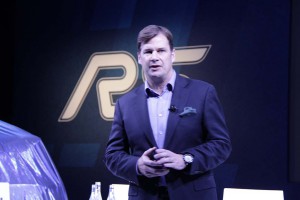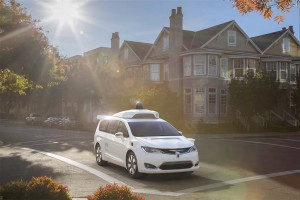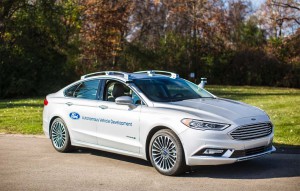
“You’re starting to see the foundation of Ford’s bet on AVs (or autonomous vehicles),” said Jim Farley.
Ford plans to shift production of electric vehicles from a suburban Detroit plant to a factory in Mexico, a top company official said. That move will make room at the Flat Rock Assembly Plant for Ford to launch a new line of driverless vehicles that will be used by ride-sharing and delivery fleets.
The move could create some political headaches for the second-largest of the Detroit Big Three automakers. During his campaign for the White House, then-candidate Donald Trump repeatedly bashed Ford’s plans to move small car production from Michigan to a second assembly plant it was building in Mexico. It ultimately scrubbed that facility and will shift production of the Focus model to China, instead.
“You’re starting to see the foundation of Ford’s bet on AVs (or autonomous vehicles),” said Jim Farley, the president of global markets for Ford.
The automaker is just one of many working on autonomous technology, but a year ago Ford said it would shift focus to fully driverless vehicles. And instead of targeting individual consumers, Raj Nair, then the head of global product development, said Ford would focus on commercial markets – in part because of the high cost of driverless technology.
Ford has put a premium on alternative mobility, everything from connected cars to ride- and car-sharing. It has spent billions on hands-free technologies, announcing a series of partnerships and acquisitions, including one that will give it access to the LIDAR, or high-definition laser, technology needed to enable fully autonomous and hands-free vehicles.
It has also announced several partnerships that could provide a market for those vehicles. That includes Domino’s Pizza, which had run a test of self-driving delivery vehicles near its headquarters in Ann Arbor, Michigan, as well as Lyft, the second-largest U.S. ride-sharing service.
Taking the driver out of the vehicle could allow companies like Lyft to slash their prices to the point where they would be substantially cheaper, on a per-mile basis, than what it costs to own a private vehicle. A recent study by the Boston Consulting Group forecast as much as a quarter of the miles Americans clock on the road by 2030 could take place in driverless vehicles operated by services like Lyft.
“While others are focusing on A-V’s for ride-hailing, our business model will be much more diverse,” said Farley. “We’ll move people and goods.”

Waymo launched a pilot ride-sharing program in Phoenix using autonomous Chrysler minivans. It will be adding more fully driverless vans.
Ford has been vague about specific plans for its first-generation driverless vehicles, though it is now indicating they will use some form of gas-electric hybrid powertrain. Company officials have said that the computer and sensor technologies needed for those hands-free vehicles would draw too much power for pure battery-electric vehicles, severely limiting their range.
The vehicles would be designed to operate 20 hours a day, seven days a week.
According to Farley, Ford will invest $200 million and add 150 new jobs to make the Flat Rock plant its center of autonomous vehicle production. That’s on top of the $700 million Ford was planning to spend to make the Michigan plant its center of electrified vehicle production. Meanwhile, the operations, now shifted to a factory in Cuautitlán, Mexico, will start up in 2020.
One of the questions that Ford officials say they can’t yet answer is how much of an impact fully driverless vehicle technology will have on long-term sales. Some analysts predict that millions of Americans, especially those in denser urban and suburban environs, will stop buying their own vehicles and shift to ride-sharing services.
(GM wants to get a leg up on Ford, launch first driverless ride-sharing vehicles by 2019. Click Here for the latest.)
Ford has been shaking up its manufacturing footprint for several years. To make room for two new light truck models, the Bronco SUV and Ranger pickup, it announced in April 2016 that it would move its small car production, including the Focus, out of a factory in Detroit’s western suburbs and into a new plant in Mexico.
That triggered a series of angry tweets by then-candidate Trump who warned Ford it could face hefty new tariffs on Mexican-made products.
But with sales of passenger cars – especially smaller models like Focus – plunging, Ford Executive Vice President Joe Hinrichs told TheDetroitBureau, the automaker decided to cancel plans for the second Mexican factory and consolidate production of the Focus into a single Chinese factory. That model is now positioned to become the single-largest automotive import from China.
The decision, Hinrichs said, had nothing to do with the president’s push to bring automotive production back from Mexico. And Ford apparently isn’t worried about any potential political repercussions from its latest announcement.
(Rinspeed Snap concept hints at what tomorrow’s driverless vehicles might look like. Click Here to check it out.)
Until recently, industry analysts expected to see automakers slowly phase in ever more complex self-driving technologies, starting with the semi-autonomous models that are coming to market in 2018. Several manufacturers had hoped to go fully hands-free by 2020. But most observers had not expected to see driverless products reach production until later in the decade.
Ford plans to start producing its first models by around 2021. But General Motors last week said it would be on the street with its first driverless vehicles – also targeting commercial customers – by 2019. And Waymo, the Google spin-off, plans to begin field-testing a small test fleet of driverless ride-sharing vehicles starting next year. During the press preview of the Los Angeles Auto Show last week, Waymo CEO John Krafcik said his company could quickly “scale up” that project to other cities.
(For more on Waymo’s Phoenix pilot program, Click Here.)


As usual, the 5 year plan is changing monthly.
Responding wisely to changing circumstances is actually a plus in today’s environment. Ping-ponging from one ill-conceived strategy to another is an entirely different matter.
Paul E.
Why no brouhaha of them moving small-car manufacturing to China? Interesting.